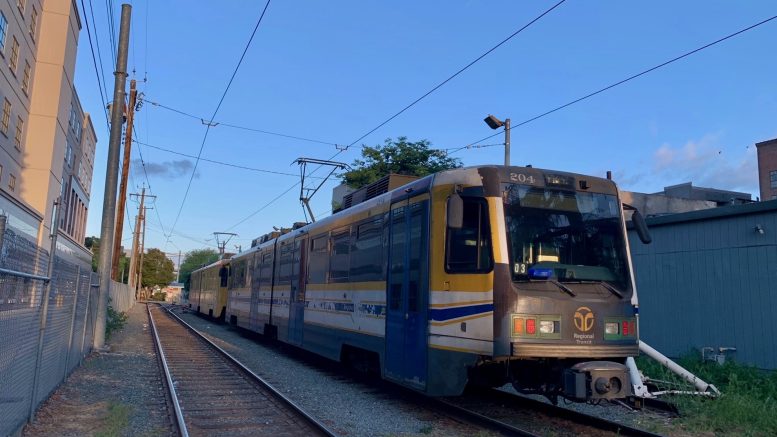‘It would be nice if there was more consistent information, instead of just showing up at the light rail stop and finding a sign that says ‘oops, sorry, you better find another way today.’
By Jacob Peterson
SacRT will soon upgrade its fleet of aging trains, replacing dozens of decades-old vehicles but also causing weekend service disruptions through spring and into summer
The service disruptions are a result of ongoing construction for the Light Rail Modernization Project, which will set the stage for incoming low-floor light rail vehicles, explained Sacramento Regional Transit Spokesperson Jessica Gonzalez.
Gonzalez added that the new trains are Siemens S700s made in Sacramento. SacRT has three trains in its possession for testing, with 28 ordered and a contract good for up to 76 vehicles.
“We have 96 trains, so we do need some more, we’ll have to work on additional funding as well,” Gonzalez noted. “This is going to be a game changer for the region.”
Officials have pointed out that SacRT’s current fleet of trains are in need of replacement, with some too old to find parts for and others in use now for over 30 years.
“Our maintenance team is amazing,” Gonzalez said. “I was recently at a convention for transit with different marketing people, and they couldn’t believe we were still operating these trains, they were shocked.”
Having low-floor vehicles also provides better accessibility for mobility-impaired and disabled commuters.
“Currently, if you are in a wheelchair or some type of mobility device that you can’t climb stairs with, you have to only use the front car on the main high ramp,” Gonzalez observed.
The plan for newer trains includes smaller ramps that will deploy with the use of a button alongside special markings to show which doors have the ramps. However, the current high ramps will remain in place until all 96 current trains can be replaced.
Gonzalez said SacRT currently has funding for work on the Gold Line for the 59th Street Station through the Sacramento Valley Station. Construction generally taken place on the weekends when ridership is only half of what it is on weekdays.
“We still do have to modify a number of other stations, but we have to get the funding first,” Gonzalez acknowledged. “We’re looking at the rest of the Gold Line, so University 65th through Historic Folsom, and we’re also looking at the Blue Line.”
Despite efforts to lessen the impact, the construction has still had an effect on people like 19-year-old retail worker Arianna McIntosh.
“I use the light rail pretty much every day to get to work,” McIntosh said. “With the construction going on it’s been a little difficult, my rides have been getting longer.”
McIntosh added that the construction being limited to weekends has helped her commute during the week, but she still wishes it could be finished sooner.
The weekend service disruptions are also hitting 62-year-old Rebecca Kennedy. A former stay-at-home mother, Kennedy has recently been using the light rail to help her look for work.
“I don’t have a car, so that’s how I would get to a job I would find,” Kennedy said.
While she understands why the construction is necessary, Kennedy hopes SacRT will get better at communicating to riders when the disruptions are happening.
“It would be nice if there was more consistent information,” Kennedy offered, “instead of just showing up at the light rail stop and finding a sign that says ‘oops, sorry, you better find another way today.’”
Gonzalez counters that SacRT is working on a communication campaign for riders to let them know when the service disruptions will be taking place, and the solutions, such as bus bridges, that will be available to them.
SacRT received $30 million in funding via a state grant in July of last year for the Modernization Project, along with over $200 million before that. Gonzalez said that, in general, SacRT has a problem competing for state and federal grants due to needing a local match.
“SacRT is really underfunded locally, we have a sixth of a cent for sales tax dollars, other transit agencies in California have a full cent,” Gonzalez said. “It really makes it challenging when we’re competing against other transit agencies for state and federal dollars.”
Gonzalez added light rail ridership is back to around 70% of what it was pre pandemic, but believes that when the new cars are implemented it will attract both former riders and new ones as well.


Coming from growing up in major cities like Atlanta & Chicago, I know from experience the “hustle & bustle” of using mass transit. Although Sacramento transit infrastructure is no where near what the major cities are, I still think SacRT does a pretty good job providing service for riders. Yes, there are some areas that I feel could be tweaked for better rider-efficiency, however, SacRT is solid in maintaining a strong dependability for it’s patrons.